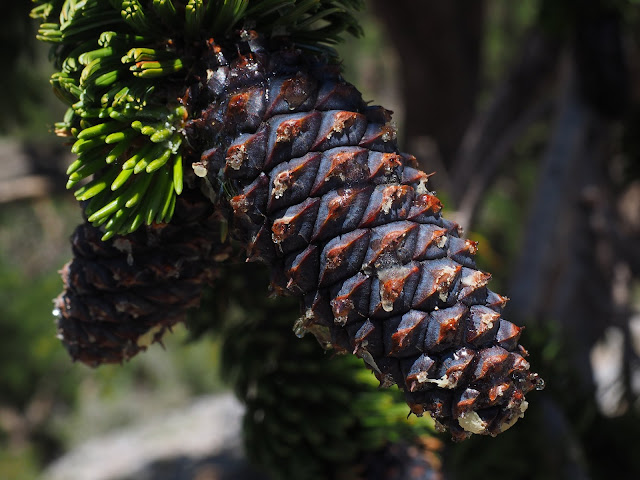There is only one kind of Fir on Mt Charleston. The White Fir. It can be recognized by its general shape. Having single needles directly on the branches unlike Pines that have their needles in clusters. The White Fir also has cones on the uppermost branches that sit upright on the branches and do not fall off onto the ground. They are eaten by squirrels and birds on the tree. The needles are also somewhat flattened and have rounded tips.
Young White Firs have pointy tops and horizontal limbs. Unlike any other tree on Mt Charleston.
Look at these needles. They come directly off the branch and curl upward. The ends are blunt and they are more flat than round. If you pick one and try to roll it between your fingers you will see how flat it is.
This is a White fir cone. Most White Firs do not have cones on Mt Charleston. In early summer they are small and green. They turn brown later. You will never find one on the ground under the tree like with Pines, Spruce, Hemlock or Douglas fir. They stay on the tree to be eaten by small animals. The cones are always on the upper branches sitting upright. Not hanging down.
White Fir cones.
White fir cones
White Fir cones.

White fir cone blown off by a high wind. About 3 inches long and 1 inch in diameter.

This cone is partially eaten by some critter. There is a spindle in the center of the cone and sometimes that is all that is left.
Ponderosa Pine is the next most easily identified Pine on Mt Charleston. Pines have needles in clusters. Like, 2, 3, or 5 needles per cluster. Ponderosa Pines are the only 3 needle pine on Mt Charleston. It is also the largest pine on Mt Charleston. It's needles are about 5-6 inches long. The cones are shorter than the needles. Large pines have thick bark that is sorta orange in color. Any pine on Mt Charleston with 3 needles in the cluster is a Ponderosa. Every cluster might not have three.....there could be some damage to the cluster, or it could just be an odd ball. Look at several clusters to see which is dominate.

Ponderosa
Ponderosa cones compared to Pinyon cones. Pinyon cones are almost round and have large scales.

Ponderosa
Pinyon pine cones
New pinyon cone.
Pinyon Pine cones
Single leaf Pinion Pine.
This is the exception to clustered needles on Pines. It has a single needle coming off the branch. It is round and pointy. The Utah version of this pine has 2 needles. They grow at low elevations mixed with junipers and sagebrush in addition to elevations around 9000 ft. This is where pine nuts come from.

Older branch of a Pinyon.
The next two pines are the 5 needle pines. Bristlecone, and Limber pine. They look a lot alike and grow at the highest elevations. Generally the Bristlecone has denser needles and darker bark.
Bristlecone
Bristlecone
Bristlecone
Very young Bristle cone.
Slightly older Bristlecone cone. Note the bristles.
Mature open cone. You can still see the bristles.
Older bristlecone, unopened on the tree.
Bristlecone
Usually Bristlecone branches are thick with needles about 1 inch long. They grow along the branches all the way to the tip. On the Limber pine they are not as dense, a little longer, and look like they are concentrated on the branch tips.

This Limber pine branch has 5 cluster needles spread out along the branch. The branch is visible and is a light color. Bristlecone is darker. The twigs of the Limber Pine are very flexible and how it got its name.
Bristlecone needles are short and have 5 per cluster. Limber needles are also 5 per bunch. I know this one is 4 per, but that is not normal. You cannot rely on the limber needles being longer. There is much variation in length. from 1-2 inches. Bristlecones are more uniform, around 1 inch.
This shows the Limber cones and that the needles are shorter than the cones. This on one way to tell it from a Ponderosa which has small cones and long needles. You can also see the light colored branches and that the needles are not crowded together as much as a Bristlecone.
Limber Pine
Side by side. Limber on left, bristlecone on right. You can see the spines on the bristlecone, and also see that the limber cone scales are much wider.
Limber Pine cone. The scales are broad. Bristlecone cones have narrow scales, and have sharp spines on each. if they haven't been broken off.
All the pines on Mt Charleston together
Some other pine cones for size comparison
All 4 pines and one Fir can occur at the same location and elevation on Mt Charleston. This is at the top of Trail Canyon on the cut across to Rain tree.





































Very informative. We have a cabin in old town and lost 7 ponderosa pines 2 years ago to Western Bark Beatles. Getting ready to replant and want to have a variety. Thank you for this great piece.
ReplyDelete